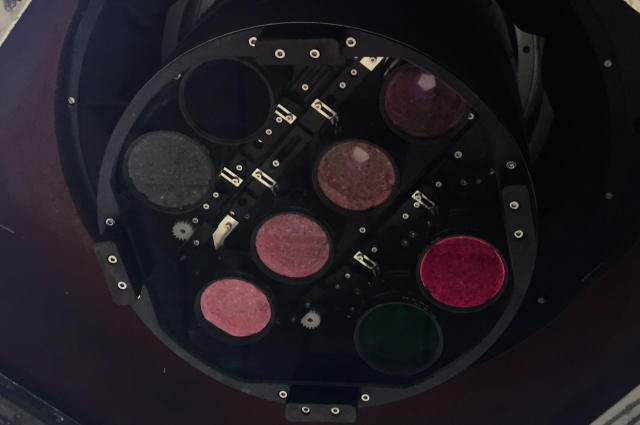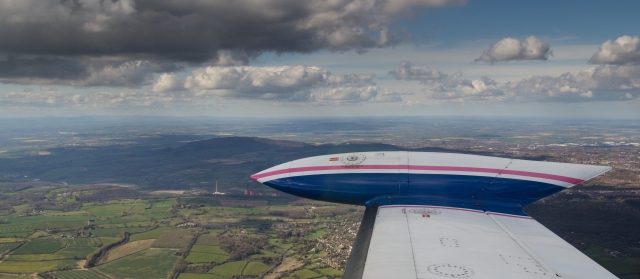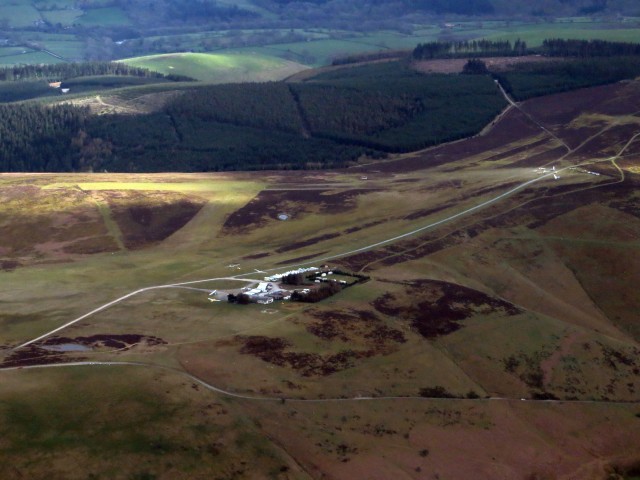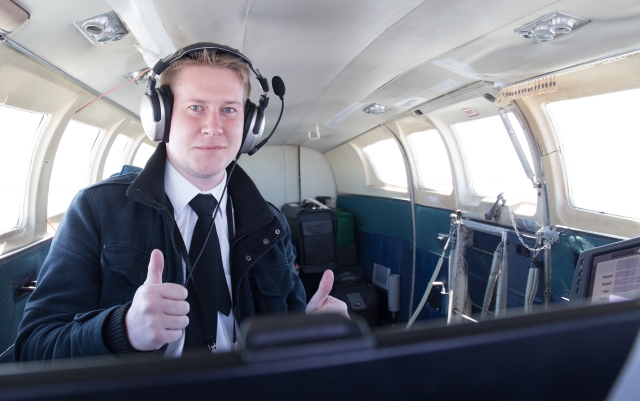Back in February I went behind the scenes at Ordnance Survey with Dom Turnor, a Field Surveyor at OS, to find out how the master map of Great Britain is updated. During the day I discovered that there are areas that cannot easily be surveyed on the ground, this can be for a variety of reasons including the size/nature of the site, access restrictions or the safety of the surveyor. In these situations the changes can be surveyed using aerial photography. Ordnance Survey have had a dedicated Flying Unit since 1966. OS used aerial photography prior to this and had operators of it’s own, however it was shared with the Royal Air Force and other government departments.
I met up with Air Camera Operator and Field Surveyor Roger Nock at East Midlands Airport to find out more about the Flying Unit and how they capture the aerial imagery required to update the master map.

Ordnance Survey have several planes, each equipped with a large format digital aerial camera system by Vexcel Imaging. This is a state of the art UltraCam digital camera, consisting of eight lenses and 196 megapixels.
The camera/sensor unit is mounted behind the camera operators seat with the airborne computing unit, removable data storage and interface panel to the operators left. The pilot has a secondary display screen which can be mounted to the instrument panel whilst imagery is being captured.


Mounted in front of the camera operator is a forward looking scope for a detailed view of the area and terrain ahead of the aircraft.

The flying season is between late February and early November and is very much dependent on the weather, air traffic control and permission to enter areas of restricted airspace.
Not only do they have to factor in the infamous UK weather, our airspace is also one of the busiest in the Europe, if not the world, especially in the South East with the shear volume of arrivals and departures into the main London airports. In 2014, London Heathrow handled 73.4 million passengers during 470,695 aircraft movements, an average of 1290 flights a day (data from LHR Airports Ltd).
Everything needs to be in place for a flight to take place. The weather needs to be favourable, rain and clouds in the target area will cast shadows on the imagery or completely obscure the ground. Permissions from multiple air traffic controllers along the flightpath and permissions to enter restricted flight areas need to be obtained, the pilots total flying hours that day also needs to be considered, not just total flown so far but the planned flying hours for the sortie need to be taken into consideration and of course the serviceability of the aircraft itself. However, before any of this can take place the flight needs to be planned, which starts with a request for a target to be flown. These can come from various sources including, field surveyors, OS HQ etc.
One target request that needed planning whilst I was visiting was for the Glaslyn river estuary in North Wales, this estuary is predominately sand banks and needs to be accurately surveyed in order to update the master map. As you can imagine this task just isn’t feasible for a ground field surveyor to undertake.

With the target site identified, the air camera operator checks the Civil Aviation Authority (CAA) airspace charts for the location and any flying restrictions/hazardous areas. The majority of North Wales is free airspace, however there a few restricted areas with an RAF airfield on Anglesey and some of the valleys being used for low level fast jet training. In our case the Glaslyn estuary is in the free airspace, so there are no restrictions or additional permissions required.

Aerial imagery is captured by flying at a set speed and altitude in a straight line with a photo being taken approximately every 3 seconds (depending on speed).
Having entered certain details into the computer, such as Camera Type, Ground Sample Distance (GSD is the distance between the pixels on the image measured on the ground eg. in an image with a one metre GSD, adjacent pixels image locations are 1 metre apart on the ground).
The operator can then draw the flying strips onto the target area, these appear as black rectangles with the blue centre line being the flightpath of the aircraft and the red dots indicate the location an image will be captured. In order to obtain the best quality survey the images are overlapped, generally by 30%. Additional strips are added until the target area is completely covered as shown in the screenshot below.
Whilst the location of each photo is captured with GPS it is good practice to include several map features in the imagery, such as a main road or village centre, so that the newly acquired imagery can be aligned with existing map data. The original target area is the black outlined polygon just visible under the main rectangles.

In order to fully survey the estuary OS will need to fly five lines capturing a total of 144 images, with each line being flown at 5,800 feet and 175 knots. This relatively small target area will take approximately 30 to 35 minutes to survey when you add in the time it takes to turn the plane at the end of each line. In this example the altitude of each line remains constant as the terrain is flat, in more hilly areas the altitude of each line needs to be adjusted in line with the terrain so that the GSD remains constant as well. An additional element for this sortie is that it must be flown at low tide thereby adding to the complex of scheduling it.
The weather had been poor in the morning of my visit and just when it was looking like we wouldn’t get to fly at all, there was a break in the weather over South Wales and we would be able to fly a sortie. The selected target in Aberporth was a single line which would take five minutes to survey at an altitude of 5800 feet. During the week the area is restricted airspace and even though it was a Saturday permission would still be required to fly in the area.

Our pilot for the day Liam Watt had called ahead and with permission granted, the surveying systems setup and configured we took to the skies over East Midlands and set course for Cardigan.

The outbound flight took us out towards Ironbridge, south of the Wrekin and then over the Shropshire Hills and the Welsh Marches.


We had to be extra vigilant in this area by keeping an eye out for gliders, due to the number of clubs in the area and the weather was perfect for the gliders to soar on the thermals, their small size makes them difficult to see.


As we approached the target area, I heard Liam say to Roger over the intercom “cloud on the line”, this potentially meant we would have to abort the sortie and return to East Midlands without any images. Fortunately as we turned for the line it was in fact clear and Roger started capturing the imagery.
From the co-pilots seat I watched Liam’s secondary screen on the instrument panel in front of me. The images below shows: Top Left – approaching the line. Right – flying the line. Bottom Left – Line complete and turning back for East Midlands.


Roger was happy with the images he captured and with the survey complete we turned for the return flight over the Welsh Marches and the Shropshire Hills back to East Midlands airport.



Having landed and taxied back to the hanger, the last remaining tasks are to remove the data storage units from the aircraft and copy the imagery from the aircraft systems onto the servers where they will be sent to OS in Southampton for processing and updates to the master map will be made.
I would like to thank Ordnance Survey and especially Roger and Liam for giving me access to the Flying Unit for what was a fantastic experience and truly a once in a lifetime opportunity.

Fantastic article Dan, thanks for sharing.
LikeLiked by 1 person
Been waiting for this one Dan!
Well worth the wait for such a full account.
The attention to detail in #OS Maps is quite mind boggling!
Top marks to all concerned.
LikeLiked by 1 person
Great article Dan. We are so glad you could spend time with us at the flying unit and you managed to watch Rog in action on a live sortie. Stefan
LikeLiked by 1 person
Thanks Stefan, it was a great day.
LikeLike
Love it! Has to be the best way to travel from the East Midlands to glorious Snowdonia!
LikeLike
Hi Dan
Glad that I was able to make the experiences happen for you. it looks like you had an amazing day with Roger and the flying team and thanks for a very interesting article, I was waiting to read it and have not been disappointed.
Sam
LikeLike
Hi Sam, thank you for arranging everything, it was a fantastic experience that I’ll never forget. Glad you liked the posts. Thanks again.
LikeLike